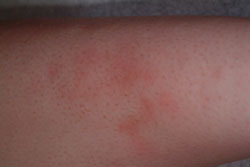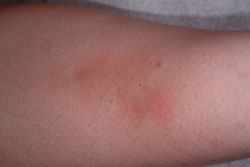Tender, erythematous nodules on the legs of a teenage girl
A 15-year-old girl presents to your office for a new rash on her legs that developed 5 days previously. She first noted several red, tender round nodules on the shins and lateral sides of her lower legs that she attributed to injuries incurred during a recent soccer game. However, she mentioned that several similar lesions on the forearms developed after she stopped playing soccer. She currently feels well, although she recalls having a sore throat and fever lasting 2 to 3 days about 2 weeks ago. On physical exam, the shins and lateral sides of her lower legs have several symmetric 1-cm to 3-cm tender, round, erythematous and violaceous indurated subcutaneous nodules. The remainder of her physical exam is notable for shotty cervical lymphadenopathy.
 |
|
Symmetric 1-cm to 3-cm tender, round,
erythematous and violaceous indurated subcutaneous nodules seen on the
patient’s lower legs. |
What’s Your Diagnosis?
Diagnosis: Erythema Nodosum
Erythema nodosum (EN) is the most common form of panniculitis (inflammation of the adipose tissue) precipitated by a host of different factors, including infectious and noninfectious etiologies. EN is classically seen in middle-aged adults, particularly women, but it is not uncommon in children. Before puberty, EN is rare but distributed equally among boys and girls. However, from puberty onward, there is a female predilection, suggesting a possible hormonal etiology.
EN is associated with a myriad of conditions, including infectious, inflammatory and malignancy-related diseases. Drugs have also been implicated in many cases. In children, infectious etiologies are by far the most common, about 40%, specifically beta-hemolytic streptococcus. Other less common infections include Mycobacterium tuberculosis, Mycoplasma pneumoniae, Yersinia enterocolitica, Campylobacter, Borrelia burgdorferi and parvovirus B19, among others. EN is also associated with inflammatory disorders such as ulcerative colitis, Crohn’s disease and sarcoidosis. Malignancy is a less common association in children.
 |
|
Multiple symmetric violaceous and erythematous
subcutaneous nodules on the shins. |
The most common medications implicated include sulfonamides, bromides, antibiotics and oral contraceptive pills. Hormones may play a role in the etiology. As the amount of estrogen in oral contraceptive pills has decreased over time, oral contraceptive pill-related EN is much less common. Occurrence during pregnancy further supports a hormonal role in certain cases of EN. Finally, in 37% to 60% of cases in the literature, the etiology cannot be identified, despite thorough evaluation, and is considered idiopathic.
EN is believed to be a type IV (delayed type) hypersensitivity reaction to an antigenic stimulus. The pathogenesis is likely secondary to immune complex deposition in the venules of the adipose connective tissue septa with subsequent complement activation and resulting inflammation. Histopathologically, panniculitides are classically divided into septal and lobular variants. EN is the prototypic septal panniculitis, demonstrating a mixed infiltrate in the septa of the adipose tissue that may spill into the lobules.

Marissa J. Perman, MD, is a third-year dermatolology resident at the University of Cincinnati.
Clinically, the disorder consists of the sudden onset of multiple symmetric tender, red nodules on the shins, ankles and knees measuring 1 cm to 5 cm. Similar nodules can occur less commonly on the thighs, arms, neck and, rarely, the face. Initially, the nodules are bright red and slightly elevated; however, during the next few days, they become more violaceous and flat. Eventually, they appear clinically, similar to resolving ecchymoses, becoming yellow-green and then a violaceous brown before resolution. Unlike other panniculitides, EN does not ulcerate or scar. The cutaneous findings typically last 3 to 6 weeks; however, the duration is often shorter in children. This may be explained by the more common association of streptococcal infection in children vs. chronic disease in many adults. Associated symptoms such as arthralgias and fever are much more common in adults.
The diagnosis is usually made clinically by history and physical examination. It is important to obtain a history of recent illnesses, medications, travel and pets. In rare cases, in which the diagnosis is unclear or in cases of recurrence, a skin biopsy may be helpful. If streptococcal infection is suspected, a throat culture should be obtained. However, cultures may be negative with past infection. In that case, an antistreptolysin O titer may be useful. Elevated erythrocyte sedimentation rate in children appears to correlate with the number of lesions. Further testing, including CBC, tuberculin skin test, chest X-ray, stool studies and other blood tests for infection, can be done in certain cases when the etiology is unclear.
Treatment is generally supportive and includes rest, nonsteroidal anti-inflammatory drugs and reassurance. Other less common treatments for more persistent and bothersome nodules include potassium iodide, colchicine and intralesional steroid injections or oral corticosteroids. Recurrence is uncommon in children. Practitioners should be aware of this common, self-limited hypersensitivity reaction in children so that patients are appropriately evaluated and treated as needed.
Disclosure: Dr. Perman has no direct financial interest in any of the products mentioned in this article nor is she a paid consultant for any companies mentioned.
For more information:
- Kakourou T. J Am Acad Dermatol. 2001;44:17-21.
- Moraes AJ. Pediatr Int. 2006;48:48-53.
- Requena L. Semin Cutan Med Surg. 2007;26:114-125.
Photos courtesy of Anita P. Sheth, MD
